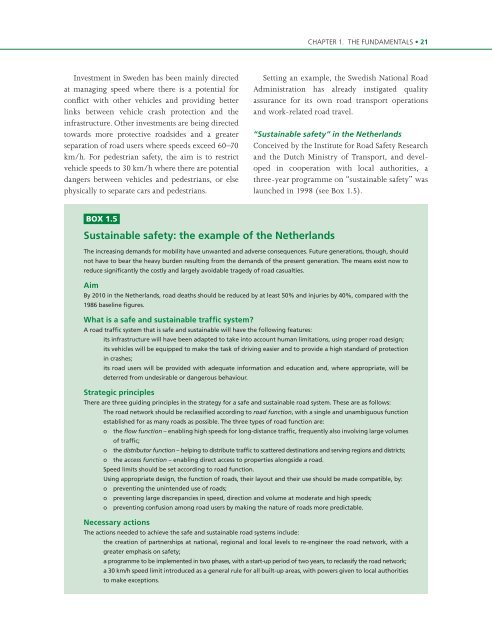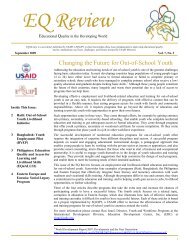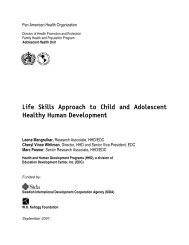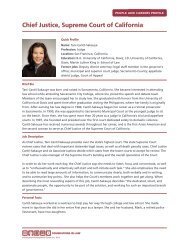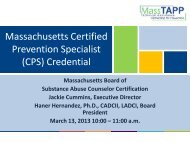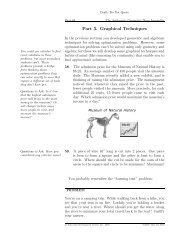World report on road traffic injury prevention edited by M ... - teach-vip
World report on road traffic injury prevention edited by M ... - teach-vip
World report on road traffic injury prevention edited by M ... - teach-vip
Create successful ePaper yourself
Turn your PDF publications into a flip-book with our unique Google optimized e-Paper software.
CHAPTER 1. THE FUNDAMENTALS • 21<br />
Investment in Sweden has been mainly directed<br />
at managing speed where there is a potential for<br />
c<strong>on</strong>flict with other vehicles and providing better<br />
links between vehicle crash protecti<strong>on</strong> and the<br />
infrastructure. Other investments are being directed<br />
towards more protective <strong>road</strong>sides and a greater<br />
separati<strong>on</strong> of <strong>road</strong> users where speeds exceed 60–70<br />
km/h. For pedestrian safety, the aim is to restrict<br />
vehicle speeds to 30 km/h where there are potential<br />
dangers between vehicles and pedestrians, or else<br />
physically to separate cars and pedestrians.<br />
Setting an example, the Swedish Nati<strong>on</strong>al Road<br />
Administrati<strong>on</strong> has already instigated quality<br />
assurance for its own <strong>road</strong> transport operati<strong>on</strong>s<br />
and work-related <strong>road</strong> travel.<br />
“Sustainable safety” in the Netherlands<br />
C<strong>on</strong>ceived <strong>by</strong> the Institute for Road Safety Research<br />
and the Dutch Ministry of Transport, and developed<br />
in cooperati<strong>on</strong> with local authorities, a<br />
three-year programme <strong>on</strong> “sustainable safety” was<br />
launched in 1998 (see Box 1.5).<br />
BOX 1.5<br />
Sustainable safety: the example of the Netherlands<br />
The increasing demands for mobility have unwanted and adverse c<strong>on</strong>sequences. Future generati<strong>on</strong>s, though, should<br />
not have to bear the heavy burden resulting from the demands of the present generati<strong>on</strong>. The means exist now to<br />
reduce significantly the costly and largely avoidable tragedy of <strong>road</strong> casualties.<br />
Aim<br />
By 2010 in the Netherlands, <strong>road</strong> deaths should be reduced <strong>by</strong> at least 50% and injuries <strong>by</strong> 40%, compared with the<br />
1986 baseline figures.<br />
What is a safe and sustainable <strong>traffic</strong> system?<br />
A <strong>road</strong> <strong>traffic</strong> system that is safe and sustainable will have the following features:<br />
its infrastructure will have been adapted to take into account human limitati<strong>on</strong>s, using proper <strong>road</strong> design;<br />
its vehicles will be equipped to make the task of driving easier and to provide a high standard of protecti<strong>on</strong><br />
in crashes;<br />
its <strong>road</strong> users will be provided with adequate informati<strong>on</strong> and educati<strong>on</strong> and, where appropriate, will be<br />
deterred from undesirable or dangerous behaviour.<br />
Strategic principles<br />
There are three guiding principles in the strategy for a safe and sustainable <strong>road</strong> system. These are as follows:<br />
The <strong>road</strong> network should be reclassified according to <strong>road</strong> functi<strong>on</strong>, with a single and unambiguous functi<strong>on</strong><br />
established for as many <strong>road</strong>s as possible. The three types of <strong>road</strong> functi<strong>on</strong> are:<br />
o the flow functi<strong>on</strong> – enabling high speeds for l<strong>on</strong>g-distance <strong>traffic</strong>, frequently also involving large volumes<br />
of <strong>traffic</strong>;<br />
o the distributor functi<strong>on</strong> – helping to distribute <strong>traffic</strong> to scattered destinati<strong>on</strong>s and serving regi<strong>on</strong>s and districts;<br />
o the access functi<strong>on</strong> – enabling direct access to properties al<strong>on</strong>gside a <strong>road</strong>.<br />
Speed limits should be set according to <strong>road</strong> functi<strong>on</strong>.<br />
Using appropriate design, the functi<strong>on</strong> of <strong>road</strong>s, their layout and their use should be made compatible, <strong>by</strong>:<br />
o preventing the unintended use of <strong>road</strong>s;<br />
o preventing large discrepancies in speed, directi<strong>on</strong> and volume at moderate and high speeds;<br />
o preventing c<strong>on</strong>fusi<strong>on</strong> am<strong>on</strong>g <strong>road</strong> users <strong>by</strong> making the nature of <strong>road</strong>s more predictable.<br />
Necessary acti<strong>on</strong>s<br />
The acti<strong>on</strong>s needed to achieve the safe and sustainable <strong>road</strong> systems include:<br />
the creati<strong>on</strong> of partnerships at nati<strong>on</strong>al, regi<strong>on</strong>al and local levels to re-engineer the <strong>road</strong> network, with a<br />
greater emphasis <strong>on</strong> safety;<br />
a programme to be implemented in two phases, with a start-up period of two years, to reclassify the <strong>road</strong> network;<br />
a 30 km/h speed limit introduced as a general rule for all built-up areas, with powers given to local authorities<br />
to make excepti<strong>on</strong>s.


